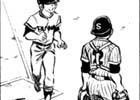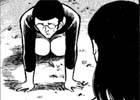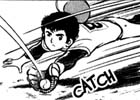Nine
| Genre: Romance/Comedy | ||
| Length: 5 Volumes (Initial Release)/2 Volumes (Wide-Ban Release) | ||
| Allegiance: Shogakukan | ||
| Mangaka: Adachi Mitsuru | ||
| Vintage: 1978-1979 | ||
| Intelligence Agency Report by: Kuzu Ryu Sen | ||
| Seishuu High School has always been a top notch academic school, without any prominent sports teams. However, this year promises to be different, for three athletic superstars are enrolling at the school: Niimi Katsuya (track), Karasawa Susumu (judo), and Kurahashi Eiji (baseball). However, because of a chance meeting with a certain Nakao Yuri at one of Seishuu’s baseball games, Katsuya and Susumu have decided to play baseball, a sport that they have no experience at. To complicate matters, Kurahashi, the saviour of Seishuu baseball, has decided not to join! With the coach’s – Yuri’s father’s – job on the line, can Katsuya and Susumu pull off a miracle, and actually help Seishuu win a game? | ||
|
|
||
| Research Agent Report by: Kuzu Ryu Sen | ||
| Plot Characters Impact Visual |
8.25 8.25 8.50 8.00 |
|
| Overall | 8.25 | |
| (not an average) | ||
| Adachi Mitsuru is not one of the better known mangaka outside of Japan, but his works are some of the most easily recognized ones in the Japanese market. One can easily see the beginnings of his trademark style in Nine, his debut work. Featuring crisp and unique artwork, a plot that revolves around baseball, and a well developed realistic and subtle romance, Nine is easily one of the better short manga out there.
The key thing about this manga is that Adachi knew his limits. He didn’t try to create an epic, and the result is that each of Nine‘s chapters are a little more loosely connected than those of his later works such as Touch. There are more sub-arcs and independent arcs, and many things are very subtle. For example, there are no triumphant love declarations, no sweeping rain soaked confessions, or anything of that nature. Even the baseball aspect is portrayed in a low key nature. Games are not stretched out for dramatic purposes, and people get over losing fairly easily. Adachi places emphasis not on result, but on development, on building character, and on naturalness. Despite how each chapter is relatively loosely tied together, the plot flows very well, and only a few moments needed a better transition. The characters are all very interesting, and their concerns, emotions, actions, and reactions all feel very natural. Characters are shy and not readily forthcoming, but they show their emotions in many other ways. Adachi has woven a web of character interaction that is complex enough to give the work depth, but shallow enough not to ruin the mood or to create problems that would take up large amounts of pages. Art-wise, you can tell that Adachi is new at this, because the first few chapters are quite rough and inconsistent. However, he’s a quick learner. By the second volume, the art has gained consistency and the clean simple drawings that Adachi is known for have become prevalent. Shading is effectively used, and action scenes tend not to be cluttered by movement streaks. There is quite an attention to detail, in terms of faces, crowds, and backgrounds as well. Nine is one of those works that’s definitely more than the sum of its parts. Realistic, poignant, amusing, and most importantly, carefree, Nine caught the attention of the Japanese manga world, and launched Adachi Mitsuru onto the manga scene. However, that was just the tip of the iceberg for this mangaka‘s talents, and he easily built on what he accomplished here with works like Touch and Rough. Every one of Adachi’s works is worth investigating, especially the one that started it all.
|
||




